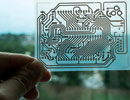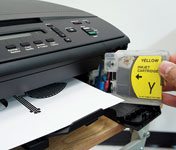
A method has been developed to make electrical circuits cheaply and quickly by printing them with commodity inkjet printers and off-the-shelf materials. According to the researchers from Georgia Tech, the University of Tokyo and Microsoft Research, this technique can produce working electrical circuits in the 60 seconds it takes to print them and for just $300 in equipment costs.
The technique, which has been dubbed ‘instant inkjet circuits’, allows the printing of arbitrary-shaped conductors onto rigid or flexible materials, and could speed prototyping of relatively basic circuits.

Recent advances in chemically bonding metal particles allowed the researchers to use silver nanoparticle ink to print the circuits and avoid thermal bonding, or sintering, a time consuming and potentially damaging technique due to the heat. The research showed that printing the circuits on resin-coated paper, PET film and glossy photo paper worked best, while materials such as canvas cloths and magnet sheets are best avoided.
“Everything we introduced in our research is available in the market and makes it possible for people to try this at home,” said Yoshihiro Kawahara, associate professor at the University of Tokyo and the primary investigator who developed the methodology while in Atlanta. “The method can be used to print circuit boards, sensors and antennas with little cost, and it opens up many new opportunities.”
To make the technique possible, researchers optimised commercially available tools and materials including printers, adhesive tape and the silver ink.

Designing the circuit itself was accomplished with desktop drawing software, and apparently even a photocopy of a drawing can produce a working circuit.
Once printed, the circuits can be attached to electronic components using conductive double-sided tape or silver epoxy adhesive, allowing full-scale prototyping in mere hours. The homemade circuits might allow tinkerers to quickly prototype crude calculators, thermostat controls, battery chargers or any number of electronic devices.
“Using this technology in the classroom, it would be possible to introduce students to basic electronics principles very cheaply, and they could use a range of electronic components to augment the experience,” said Steve Hodges, a team member from Microsoft Research.
To demonstrate the capabilities of the new technique for capacitive touch sensing and the flexibility of the printed circuits, the researchers attached a capacitive ribbon with embedded inkjet-printed circuits into a drinking glass. The capacitive ribbon sensor formed to the contour of the glass and, when connected to a microcontroller, was able to measure how much liquid was left in the glass.
© Technews Publishing (Pty) Ltd | All Rights Reserved